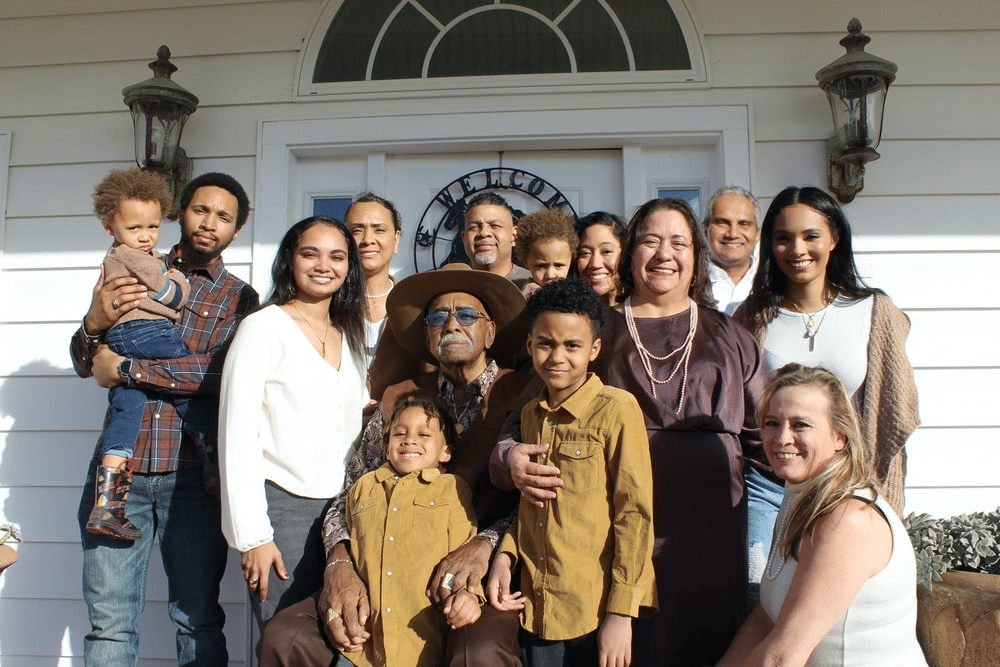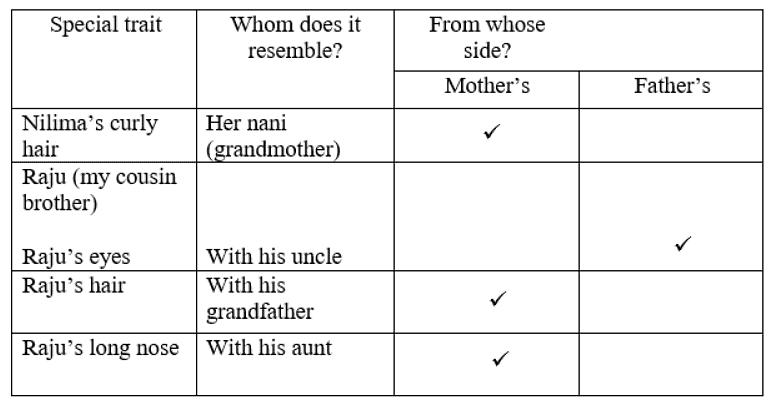NCERT Solutions for Class 5 EVS Chapter 21 - Like Father, Like daughter
| Table of contents |

|
| Fill in the Table |

|
| Tell |

|
| Find Out |

|
| Find out And Write |

|
| Discuss |

|
| This from the family |

|
| Some From Family, Some from the Environment |

|
| What we have Learnt |

|
Fill in the Table
1. Ashima sneezed just like her father. Do you have any such habit or trait which is similar to that of someone in your family? What is it? Whom is it similar to?
Ans.

Tell
1. Does your face or anything else look similar to that of someone else in your family? What is it?
Ans. Yes, some of my facial features and voice resembles that of my family members. These are:
(i) My brown eyes – just like my mother.
(ii) My broad forehead – just like my paternal grandfather
(iii) My thick nose – just like my maternal grandmother.
2. Did someone tell you this or did you find it out yourself?
Ans. I was told about this by my mother and grandmother.
3. How do you feel when people compare you with someone else in your family? Why do you feel so?
Ans. When people compare me with my mother I feel very good because my brother is very beautiful and I feel very good to listen that I am like her.
4. Who laughs the loudest in your family? Laugh like the person.
Ans. My paternal grandmother laughs the loudest in my family.
5. Make a list of all the family members from Nilima’s Nani to little Samir. How are they all related to Nilima? Write.
Ans. A list of the names of all the family members from Nilima’s Nani to little Samir and their relationship with Nilima is given below:
Nani – Nilima’s nani (Mother’s mother)
Eldest Nani – Nilima’s Nani’s sister
Elder son of Nani - Niliima’s mama (Mother’s brother)
Kiran – Nilima’s mama (Mama’s daughter)
Samir – Nilima’s nephew (Son of her sister)
Find Out
1. In your family are there any such examples of uncle-nephews or brother or sister, where there is a big difference in age? Find out from your elders.
Ans. Yes, I do have many uncle-nephews, brothers, and sisters in my family where there is a big difference in age.

Find out And Write
1. Does Nilima have curly hair like her Nani? Now you look for some special trait in your sister or brother (could also be cousins). Like the color of eyes, dimples in cheeks, height, broad or sharp nose, voice, etc. See if this trait comes from the father’s side or the mother’s side. Make this table in your notebook and fill it. An example is given.

Ans.

2. Have you seen a very young child in your family? Whom do the child’s eyes, nose, hair, or fingers look like in the family? Write their names.
Ans. Yes, I have seen the young child of my uncle, some of his special characteristics and the names of the people with whom this resemble are given below:
(i) Eyes – just like his father
(ii) Nose – just like his Mama
(iii) Hair – just like his bua
(iv) Fingers – just like his Mausi
3. Nilima’s hair is like her nani’s – thick and curly. Nilima’s mother has straight, brown and limp hair. What type of hair do you have black or brown, oily or dry?
Ans. My hairs are brown and oily.
4. What is the color of your hair? Measure and write the length of your hair.
Ans. The color of my hair is brown. My hair is 60 cm long.
5. Is your hair like that of anyone else in your family? If yes, then name the person.
Ans. Yes, my hair resembles those of my mother.
6. Measure the hair of other members of your family.
Ans. The length of the hair of the other member of your family is:
Father – 4 cm
Mother – 65 cm
Sister – 50 cm
Brother – 6 cm
7. Who has the longest hair in your family?
Ans. My mother has the longest hair in my family.
8. How many people do you know whose hair is longer than a meter? Does having long hair run in their family?
Ans. I know about two people whose hair is longer than a meter, my friend Rita and her sister Sita. Yes, having long hair runs in their family.
9. Do you know how to measure your height? Measure yourself from head to toe and write how tall you are.
Ans. Yes, I know how to measure my height. It is measured by using a meter scale or an inch tape. My height is about 110 cm.
10. How tall do you think will be when you grow up? Is anyone else in your family of the same height?
Ans. I think when I will grow up, my height will be around 155 cm. My mother is almost of the same height.
Discuss
1. What is similar between Saroja and Suvasini? What is different?
Ans. Since Saroja and Suvasini are twin sisters, therefore, their facial features eyes, height, etc. are common i.e. they resemble reach places, as a result, the other qualities which they adopted, later on, are different. Saroja knows two languages Tamil and Marathi and as well, and she is good at singing but Suvasini lacks these qualities. Suvasini know about Saroja does not. These two look so alike but are so different.
2. Do you know any twins? What is similar in them? How are they different?
Ans. Yes, there are two twins in my neighborhood, one of them is a boy and the other is a girl. So, they look different.
3. Have you read or heard anything about polio? Where?
Ans. Yes, I have read and heard about polio in newspapers TV, and radio.
This from the family
1. Have you read or heard any news about pulse polio? What?
Ans. Yes, I have read and heard about pulse polio on TV, radio, in newspapers, and on hoardings on the roadside. The government has been running a free pulse polio program under which all children below five years are vaccinated against polio free of cost on specific dates as decided by the Health Ministry. Besides, the vaccination is available free of cost in most dispensaries and hospitals.
2. Do you know of anyone who has polio?
Ans. Yes, there is a boy in our class who is suffering from polio. One of his legs is not functioning properly and he uses a stick to walk.
Some From Family, Some from the Environment
1. Are there people in your house who talk loudly? Is it their habit or they cannot hear very well also?
Ans. Yes, my Nanaji talks very loudly. Actually, he cannot hear properly as well.
2. Are there times when you do not talk loudly in from of some people? When? With whom? Why? When can you speak loudly?
Ans. Yes, I do not talk with my grandmother and father. This is because I have great respect for them and also because I am a little scared of them. I can speak loudly with my friends.
3. Some people use a machine in their ears to help them hear better. Some use a stick or spectacles to help them in other ways. Do you know someone who does so?
Ans. Yes, my nanaji uses a machine in his ear to help him near better. My dadaji use spectacles and a stick to walk.
4. Talk to people who cannot hear very well. Find out if they had this problem from birth. When did they start to have a problem with hearing? What difficulties do they face?
Ans. Yes, my grandfather cannot hear very well. He was not like this since birth. But, at the age of 30, he got a serious ear infection due to which he developed hearing a problem. Due to this, he has to face many difficulties.
(i) He finds it difficult to cross a road as he cannot hear the traffic horns properly.
(ii) He finds it difficult to communicate with people.
(iii) He finds it difficult to listen to the radio/TV.
What we have Learnt
1. What do you think – What all is a part of you that you got from your mother’s side?
Ans. I have got the following features from my mother’s side:
(i) My brown eyes – just like my mother
(ii) My soft voice – just like my mausi
(iii) My thick nose – just like my nani
(iv) My broad forehead – just like my mama
|
37 videos|244 docs|41 tests
|
FAQs on NCERT Solutions for Class 5 EVS Chapter 21 - Like Father, Like daughter
| 1. What is the importance of family in shaping a person's personality? |  |
| 2. How does the environment contribute to a person's personality development? |  |
| 3. What are some specific traits that can be inherited from parents? |  |
| 4. How can individuals learn from their family members? |  |
| 5. What are the potential impacts of a dysfunctional family on a person's personality development? |  |





















